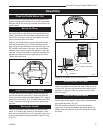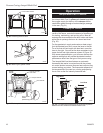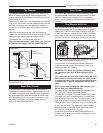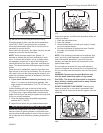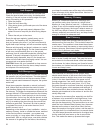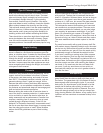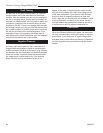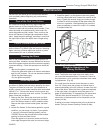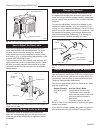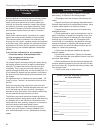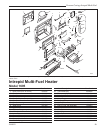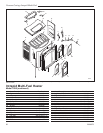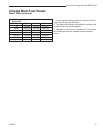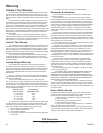
28
Vermont Castings Intrepid Multi-Fuel
2000970
Stove Serial No. __________________________
Dealer _________________________________
________________________________________
________________________________________
Phone __________________________________
Date Purchased __________________________
Installer ___________________________
_______________________________________
_______________________________________
Phone _______________________________
Date Installed _________________________
Please record the following information
for future reference.
The Chimney System
Creosote
Your Intrepid Multi-fuel is designed to reduce creosote
buildup significantly. However, regular chimney inspec-
tion and maintenance must still be performed. For
safety, good stove performance, and to protect your
chimney and chimney connector, inspect the chimney
and chimney connector on a regular schedule. Clean
the system if necessary. Failure to keep the chimney
and connector system clean can result in a serious
chimney fire.
When wood is burned slowly, it produces tar, organic
vapors and moisture that combine to form creosote.
The creosote vapors condense in the relatively cool
chimney flue. As a result, creosote residue accumulates
on the flue lining. When ignited, this creosote makes an
extremely hot fire within the flue system that can dam-
age the chimney and overheat adjacent combustible
material.
If you do have a chimney fire, act promptly to:
• Close the damper and thermostat lever.
• Get everyone out of the house.
• Call the Fire Department.
You should inspect the system every two weeks during
the heating season as part of a regular maintenance
schedule. To inspect the chimney, let the stove cool
completely. Then, using a mirror and a strong light,
sight up through the flue collar into the chimney flue. If it
is not possible to inspect the flue system in this fashion
the stove must be disconnected to provide better view-
ing access.
If a significant layer of creosote has accumulated - 1/8”
(3mm) or more - remove it to reduce the risk of a chim-
ney fire.
Clean the chimney using a brush the same size and
shape as the flue liner. Flexible fiberglass rods are used
to run the brush up and down the liner, causing any
deposits to fall to the bottom of the chimney where they
can be removed through the clean out door.
The chimney connector should be cleaned by discon-
necting the sections, taking them outside, and removing
any deposits with a stiff wire brush. Reinstall the con-
nector sections after cleaning, being sure to secure the
individual sections with sheet metal screws.
If you cannot inspect or clean the chimney yourself,
contact your local Vermont Casings, Majestic Prod-
ucts authorized dealer or hire a professional chimney
sweep.
Annual Maintenance
Perform a thorough cleaning, inspection and repair
each spring, at the end of the heating season.
• Thoroughly clean the chimney and chimney con-
nector.
• Inspect the chimney for damage and deterioration.
Replace weak sections of prefabricated chimney. Have
a mason make repairs to a masonry chimney.
• Inspect the chimney connector and replace any
damaged sections.
• Check gasketing for wear or compression, and re-
place if necessary. A ‘paper test’ will guide you on this.
Close and lock the door or damper on a slip of paper
and then try to pull the paper out. If the paper pulls
out with little or no resistance, the gasket is not snug
enough at that spot. If adjusting the damper or latch
does not result in a seal that makes it hard to pull the
paper out, replace the gasketing.
• Check door and damper handles for tightness.
Adjust if needed.
• Check heat shield screws. Tighten as necessary.
• Clean dust from the inner sides of bottom, rear and
connector heat shields.
• Remove ashes from the ash pan and replace with
moisture absorbing material (such as cat litter) to keep
the stove interior dry. Close the stove door to keep cats
from using the litter.
• Touch up the paint on black stoves.



